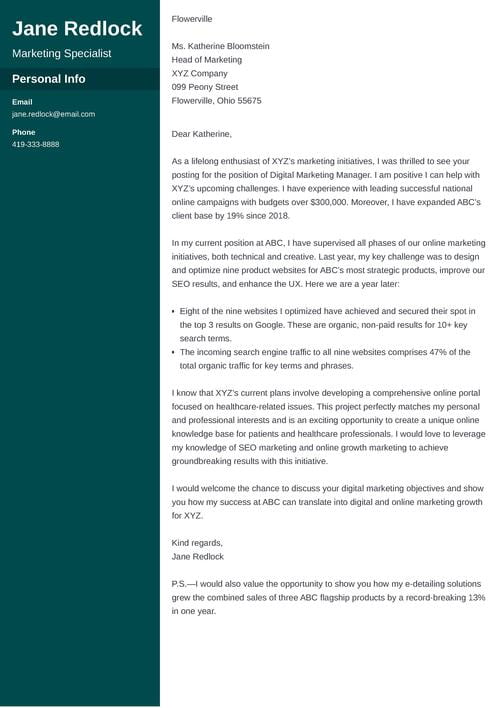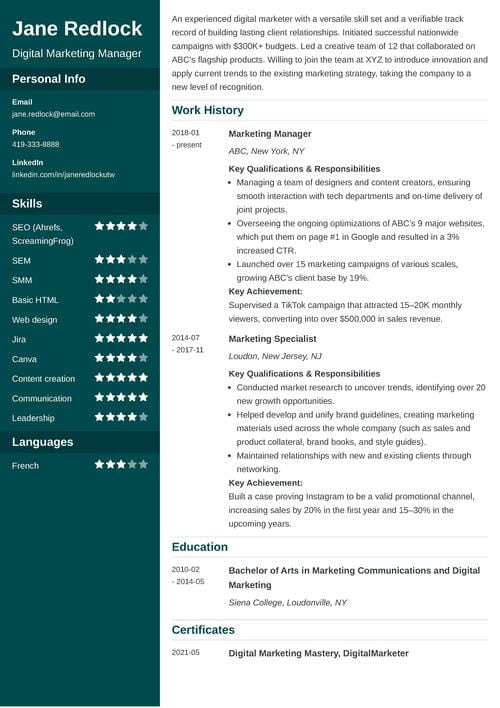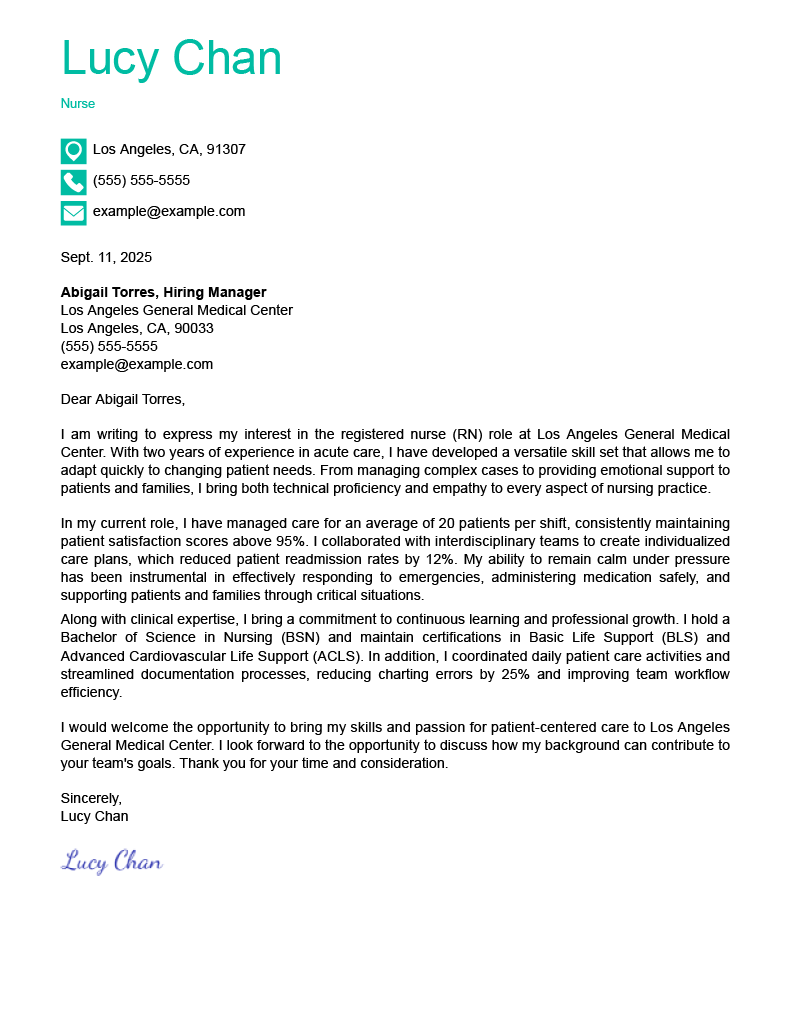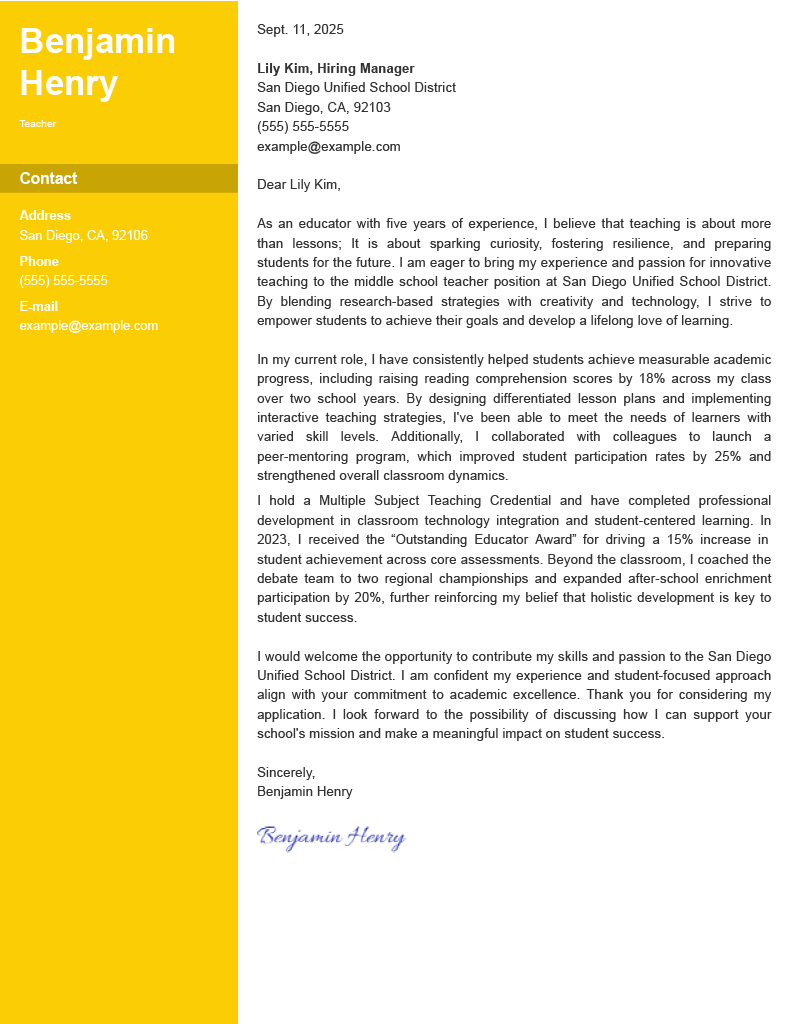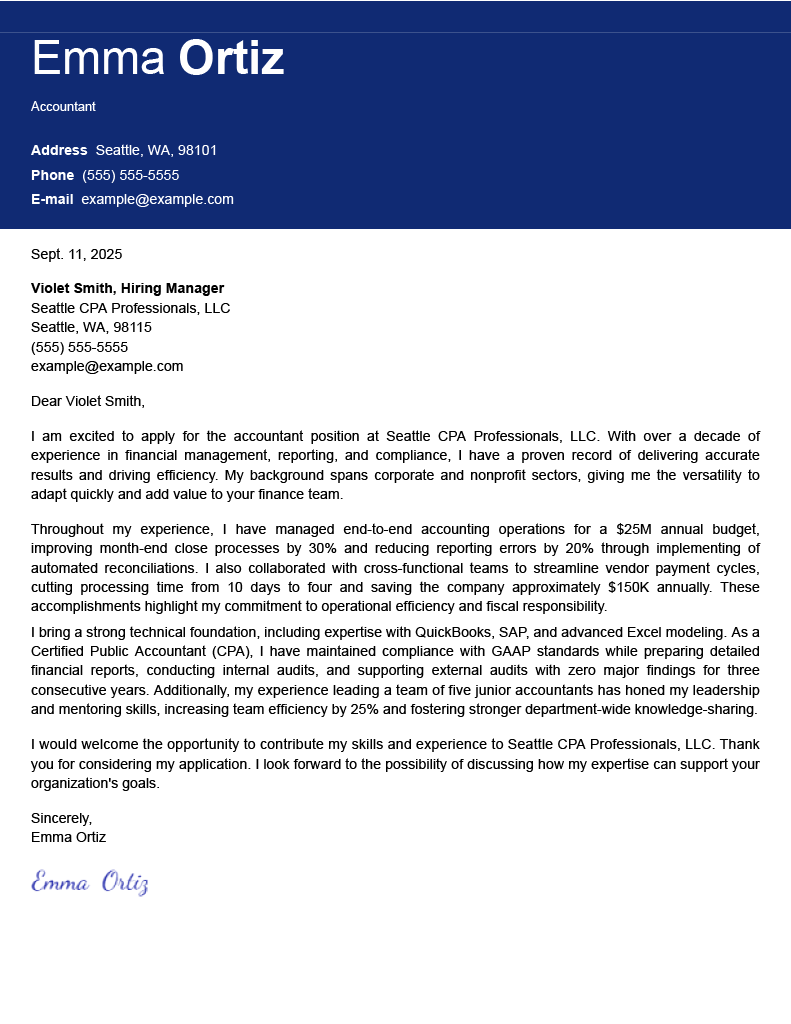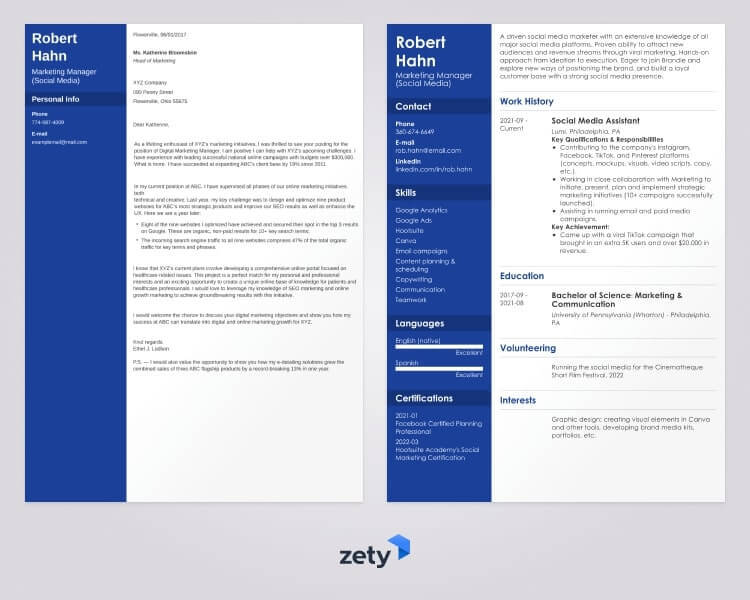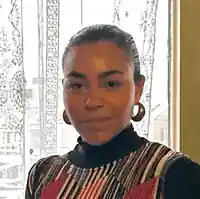Think of your resume as the scoreboard—it shows the results of your skills and experience. The cover letter, on the other hand, is the play-by-play commentary. It explains how you got those results, what motivates you, and why you'd be a strong teammate.
While a resume lists your qualifications, the cover letter connects the dots, showing employers the person behind the bullet points. Done right, it helps you stand out and makes hiring managers want to know more.
In this article, you'll learn how to write a cover letter step by step, along with strong examples and expert tips.
Want to write your cover letter fast? Use our Cover Letter Builder. Choose from 20+ professional cover letter templates that match your resume. See actionable examples and get expert tips along the way.
Sample cover letter for a resume—See more cover letter samples here.
How to Write a Good Cover Letter
Writing a cover letter is all about expanding on your resume. The key is showing the employer not only your skills, but also how well you fit in the company's culture.
Let's go over how to write a cover letter for a resume, step by step:
Step 1: Prepare all the necessary information
An effective cover letter starts with research. You need to understand the job and the company, and how you can tailor your message to the role.
Here are key details to focus on:
- Job requirements: Carefully read the job posting to understand the skills, experience, and responsibilities needed for the role.
- Company culture and goals: Visit the company's website, social media, and recent news updates. Understanding their culture and plans will help you craft a cover letter that shows why you're the right fit.
- Hiring manager's name: Addressing your letter to a specific person shows you took the time to tailor it. Look for the hiring manager's name in the job description, LinkedIn, or the company's website.
- Your qualifications: Make note of achievements, educational background, skills, and any experience that proves you're the right candidate for the role.
Step 2: Format your cover letter
A clear and professional layout makes your cover letter easy to read and leaves a strong first impression. Follow these simple cover letter formatting rules:
- Choose a standard font: Use a professional font like Arial, Calibri, or Times New Roman. Set the size between 10 and 12 points to maximize readability.
- Set consistent margins: Keep 1-inch margins on all sides and left-align text for a polished look.
- Use proper spacing: Apply single to 1.15 line spacing and leave a blank line between paragraphs.
- Keep it concise: Limit your cover letter to one page to maintain the hiring manager's attention.
- Use a professional file name: Save your file as JobTitle-CoverLetter-YourName.pdf to ensure clarity and easy access.
Step 3: Create a header
For a consistent look, consider using the same header format as your resume template. This keeps your application visually cohesive and easy to recognize.
Include the following essential details in your cover letter header:
- Full name
- Job title
- Phone number
- Professional email address
- ZIP code, city, and state
- Online portfolio or professional website
Step 4: Add the recipient’s contact details
After writing the current date, include the recipient's contact information. For example:
- Full name and job title
- Company name
- Address
Step 5: Address the hiring manager correctly
Addressing the hiring manager by name adds a personal touch and shows you took the time to tailor your letter. If you're unsure of their gender or want to avoid assuming, use their full name (e.g., Alex Clark).
If you know the recipient's gender, use the title "Mr." or "Ms." For example:
- Dear Ms. Campbell,
- Dear Mr. Casanova,
Avoid informal greetings such as "Hello" or "Hi." Similarly, "Dear Sir/Madam" or "To Whom It May Concern" are outdated.
If you can't find their name, opt for "Dear Hiring Manager" or address it to the team who will be reviewing your application, such as "Dear HR Team."
Pro tip: Addressing the hiring manager is the standard. However, some companies may ask that the letter be addressed to the HR department or a specific person. Always follow the job listing’s instructions.
Step 6: Write an attention-grabbing introduction
Hiring managers often skim applications. If the first paragraph of your cover letter doesn't grab their attention, they may not read the rest.
To make a strong impression right from the start, lead with an achievement that directly relates to the job or mention a notable news story from the company that shows you did your research.
Continue your introduction by emphasizing your enthusiasm. If applicable, you can include the name of an employee who referred you to establish a further connection.
Here’s an example:
| EXAMPLE |
|---|
As a flight attendant at Skyway Airlines, I was honored to receive the “Above & Beyond Service Award” for resolving an in-flight medical emergency while staying calm and communicating reassuringly with passengers. When I learned that Aurora Air was recently featured in Travel Weekly for its industry-leading customer care, I knew this was the perfect opportunity to bring my skills to a team that values both safety and service. I’m excited to contribute my experience in international routes and my passion for creating memorable travel experiences to support Aurora Air’s reputation as a passenger-first airline. |
Step 7: Explain why you’re the perfect fit
Writing a great cover letter isn’t just about listing qualifications—it’s about convincing the hiring manager that you’re the perfect fit. The body of your letter must clearly connect your work experience, skills, and accomplishments to the company’s needs.
Instead of repeating your resume, focus on impact: What have you achieved that proves you can excel in this role? What value can you bring to the company?
Here’s how to do it:
- Start with a key qualification: Show that you understand the role and highlight one of your strongest, most relevant skills.
- Give a specific example: Use a real accomplishment to back up your claim.
- Connect it to the company’s needs: Explain how your experience makes you an excellent match for this particular employer.
Let’s continue with the same example:
| EXAMPLE |
|---|
In my current role, I’ve mastered the balance between efficiency and empathy that passengers expect from their flight crew. Last year alone, I managed over 500 long-haul flights while maintaining a 98% passenger satisfaction rating, demonstrating my ability to deliver consistent, high-quality service under demanding conditions. I know that Aurora Air’s commitment to exceptional in-flight experiences requires crew members who can anticipate passenger needs and resolve issues swiftly. I am confident that my track record aligns perfectly with that mission. Beyond service, safety has always been my top priority. I am CPR and AED certified, and I’ve led pre-flight safety briefings for crews of up to 12 attendants. One notable example was when I coordinated an emergency landing response after a severe case of passenger illness, ensuring procedures were followed seamlessly and passengers remained calm. Aurora Air’s emphasis on safety excellence resonates with me, and I’m eager to bring my training and leadership experience to strengthen your cabin crew. |
Step 8: End your cover letter on a high note
The final paragraph of your cover letter is your last chance to convince the hiring manager to contact you for an interview. Use this section to reinforce your value and express enthusiasm for the next steps.
Here's how:
| Right |
|---|
Working alongside diverse crews and serving passengers from all over the world has taught me the value of teamwork, adaptability, and cultural sensitivity. I thrive in environments that bring people together. I would welcome the opportunity to bring this spirit of collaboration and service excellence to Aurora Air's cabin crew. I look forward to the opportunity to discuss how my experience and enthusiasm can contribute to your team's continued success. |
After you’ve written your final paragraph, wrap up with a formal yet friendly closing:
- Best regards,
- Kind regards,
- Sincerely,
- With best regards,
Step 9: Proofread your letter
Once you've finished your letter, proofread it at least once to ensure accuracy. Then, ask a colleague, mentor, or friend to read it. A new set of eyes can catch spelling or grammar mistakes, and gauge if the letter reads how you want it to.
How to Write a Cover Letter With No Experience
Writing a cover letter with no experience may feel challenging, but it's easy once you know what to focus on. Use the writing guide from the last section and follow these tips:
- Highlight transferable skills: Focus on abilities like communication, teamwork, problem-solving, or organization that apply across jobs—even if they weren’t gained in a traditional work setting.
- Leverage nontraditional experience: Volunteer roles, internships, school projects, or extracurricular activities can all demonstrate responsibility, leadership, and initiative.
- Emphasize classes that connect to the role: If you've taken relevant coursework, showcase assignments, research, or group projects that prove your knowledge.
- Show enthusiasm for learning: Employers value candidates who are eager and motivated. Express your excitement about growing with the company.
- Connect your story to the role: Explain why the position interests you and how your background—no matter how nontraditional—prepares you to succeed.
- Focus on impact, not tasks: Instead of simply stating what you did, highlight what you achieved or learned from your experiences.
Are Cover Letters Necessary?
Cover letters are necessary because they do what a resume can’t: They tell your story. While a resume lists your skills, education, and experience, a cover letter connects the dots. It shows hiring managers why you’re the right fit for the role.
In fact, 89% of recruiters expect a cover letter with a job application. Submitting a cover letter gives you the chance to highlight your achievements, explain your motivation, and add personality to your application.
In short, a strong cover letter helps you stand out from other candidates and makes employers want to learn more about you.
Cover Letter Examples for Inspiration
Check out these cover letter examples to see how other job seekers use their professional story and skills to convince employers they’re the right candidate for the role.
Nurse cover letter
Teacher cover letter
Accountant cover letter
Expert Tips for an Effective Cover Letter
Follow these tips to take your cover letter to the next level:
- Use keywords from the job description: Many companies use applicant tracking systems (ATS) to screen cover letters. Identify keywords in the job listing and naturally add them into your letter to increase your chances of passing the initial scan.
- Match your cover letter to your resume: Pick a matching cover letter template to go with your resume to send a cohesive job application package.
- Tell a short, impactful story: Anecdotes make your cover letter more engaging. Briefly describe a real challenge you solved and how the experience helped you grow professionally.
- Showcase soft skills: Soft skills like leadership, adaptability, and teamwork are essential across industries. Include them to show you're a balanced candidate.
- Use confident language: Avoid passive language, such as "I believe I might be a good fit." Opt for action verbs and strong phrasing that displays confidence.
Browse our full collection of professional cover letter examples to find the perfect match for your industry and career goals.
Plus, a great cover letter that matches your resume will give you an advantage over other candidates. You can write it in our Cover Letter Builder here. Here's what it may look like:
See more cover letter templates and start writing.
Key Takeaways
Here are a few key points to remember when writing your cover letter:
- A cover letter is your chance to explain why you’re a great fit and let your personality shine. Remember, 89% of recruiters expect one.
- Lead with a proud accomplishment, a connection to the company, or a referral to make hiring managers want to keep reading.
- Show you’ve done your research and explain why your skills, achievements, and enthusiasm make you a perfect fit for their team.
- Even if you lack direct experience, talk about abilities like teamwork, problem-solving, and communication that matter in any job.
- Volunteer work, internships, school projects, or clubs can all prove you have relevant skills and initiative.
- Share a short example of a challenge you solved or a project you completed to show your impact.
- Include keywords from the job description to pass screening systems and use a cover letter style that matches your resume.
About Zety’s Editorial Process
This article has been reviewed by our editorial team to make sure it follows Zety's editorial guidelines. We’re committed to sharing our expertise and giving you trustworthy career advice tailored to your needs. High-quality content is what brings over 40 million readers to our site every year. But we don't stop there. Our team conducts original research to understand the job market better, and we pride ourselves on being quoted by top universities and prime media outlets from around the world.
